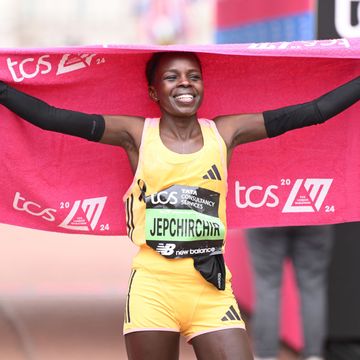Whether you're ready to start racing or are new to running altogether, you might be wondering how far you'll need to run in order to hit your training or race day targets. How far is a 5K in miles? And why is a marathon the length that it is? We've rounded up answers to the most common distance-related questions below.
Popular race distances
How many miles is a 5K?
A 5K is to 3.1 miles, which makes it an ideal choice for your first race.
The 5K is one of the most accessible and, as some would argue, most enjoyable running distances out there. Training for a 5K race is not an all-consuming endeavour, either, and can fit quite easily around other life commitments. Comparatively speaking, the race itself is also over fairly quickly.
If you're completely new to running or building back from an injury, our beginner's 5K training plan will help you to work up to distance steadily but safely.
If you're already used to running at least three or four times a week, and have done so for a minimum of two months, then our intermediate 5K training plan is perhaps a better fit for you. Before you start this plan, your weekly mileage should be around nine miles – including a long run of three miles – and you should be able to run for about 30 minutes without stopping.
If you're a more advanced runner, you may want to run your 3.1 miles faster and stronger than you've done in the past. To get better, you'll want to slot different types of running into your weekly training, such as hill workouts, speed sessions and longer runs.
How many miles is a 10K?
A 10K is 6.2 miles, and one of the most popular race distances out there – for good reason. While it challenges you to run at a fast pace over a longer distance, a 10K won't wipe you out completely, making it a great option for new runners and more experienced racers alike.
Every year, tens of thousands of runners flock to 10K races in the UK and overseas. If you've signed up for a 10K race, we recommend spending at least eight weeks preparing for the event so you know you can complete all 6.2 miles comfortably.
How many miles is a half marathon?
A half marathon is 13.1 miles, or about 21.1km.
Many runners find the half marathon distance appealing. It's far enough to warrant dedicated training and endurance, but not nearly as much as that required to finish a full marathon. Few, untrained runners can finish a half marathon on a whim in the way that they might be able to run a 5K, and yet preparing for the 13.1-mile won't take over your life. The half marathon also serves as a great stepping stone to help you move up to the marathon distance.
How many miles is a marathon?
The marathon, as you may have suspected, is twice the length of a half marathon. So, that's 26.2 miles, or about 42.2km.
Running a marathon is not an easy task for many people – but that's also why it can be one of life’s most rewarding achievements. If you commit to proper training that aligns with your goals and running ability, completing or getting your fastest time in a marathon is within your reach. It’s generally recommended that runners train for 16 to 20 weeks before taking on the full marathon distance.
Why is a marathon 26.2 miles?
The marathon distance stems from the ancient story of Pheidippides, the Greek messenger who is said to have run some 25 miles from Marathon to Athens to deliver the news of a Greek battlefield victory. The first Olympic marathon, measuring 40 kilometres – or just under 25 miles – was held in Athens in 1896. The current distance of 26 miles, 385 yards was first run at the 1908 Olympic Games.
How far is an ultramarathon?
Any footrace that is longer than 26.2 miles – a marathon – is considered an ultramarathon. The most common ultramarathon distances are 50K (31 miles), 50 miles (80.4km), 100K (62 miles) and 100 miles (160.9km).
That said, the ultramarathon world encompasses all kinds of other formats, including 24- and 48-hour races, multi-stage events and concepts such as 'last runner standing' and 'fastest known times'. Many ultramarathons are run on trails, so be sure to equip yourself with some sturdy trail shoes and kit before you get going – especially since some items are mandatory for ultramarathon races.
Other race distances
If you'd rather go for something less mainstream but not too outlandish, consider running a slightly lesser known (but no less important) distance. These distances include the 8K (which is just shy of 5 miles), 15K (9.3 miles) and 10 miles (16.1km).
Much shorter, single mile events are also gaining in popularity. These are ideal for those who have just dipped their toes into running, as well as those who really want to put their explosive speed to the test.
Distances on the running track
The length of one lap of a standard outdoor running track is 400m, as measured in lane one. This is just less than a quarter of a mile. One lap on a standard indoor track, meanwhile, is 200m, which is exactly half of the distance of a standard outdoor track.
Here are some other helpful running track measurements:
- 100m: the length of one straightaway
- 800m: roughly half a mile, or two laps of the track
- 1600m: roughly one mile, or four laps of the track
The 5000m and 10,000m are also popular race distances, and essentially track equivalents of the 5K and 10K respectively. The 5000m equates to 12.5 laps of the track, and the 10,000m 25 laps.













